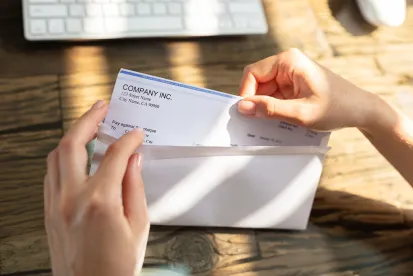On June 11, 2020, the Small Business Administration (SBA) and the U.S. Department of the Treasury (Treasury Department) released their latest guidance in the form of Paycheck Protection Program –Revisions to First Interim Final Rule (the Revised Interim Final Rule). On June 12, 2020, the Treasury Department and the SBA posted Additional Revisions to First Interim Final Ruledealing with the eligibility of certain applicants that have been convicted of a felony within the last five years, and on June 17, 2020, posted Revisions to the Third and Sixth Interim Final Rules, updating the Interim Final Rule on Additional Eligibility Criteria and Requirements for Certain Pledges of Loans and the Interim Final Rule on Disbursements. These changes address developments since the promulgation of the CARES Act, subsequent guidance issued by the government and our prior GT Alerts on the PPP. Also on June 17, 2020, the Treasury Department and SBA posted a revised simplified application, Form EZ, for loan forgiveness. Updates based on these developments are included below in blue text for ease of reference.
The Revisions to First Interim Final Rule amend the SBA’s initial interim final rule posted on April 2, 2020, by changing key provisions, such as the loan maturity, deferral of loan payments, and forgiveness provisions, to conform with the Paycheck Protection Program Flexibility Act of 2020 (the Flexibility Act) that was signed into law on June 5, 2020, amending the CARES Act (Pub. L. 116-136). With these revisions, the SBA also is making conforming amendments to the use of PPP loan proceeds for consistency with amendments made in the Flexibility Act. Several of these amendments, although not all, are retroactive to the date of enactment of the CARES Act. This guidance is intended to give borrowers seeking forgiveness of their PPP loans a better understanding of the process, subject to future regulatory or legislative changes.
Eligibility Requirements
The First Interim Final Rule provided, among other things, that a PPP loan will not be approved if an owner of 20% or more of the equity of the applicant has been convicted of a felony within the last five years. The SBA Administrator, in consultation with the Secretary of the Treasury, has determined that a shorter timeframe for felonies that do not involve fraud, bribery, embezzlement, or a false statement in a loan application or an application for federal financial assistance is more consistent with Congressional intent to provide relief to small businesses and also promotes the important policies underlying the First Step Act of 2018 (Pub. L. 115-391). Accordingly, a PPP loan will now not be approved if an owner of 20% or more of the equity of the applicant is incarcerated, on probation, on parole; presently subject to an indictment, criminal information, arraignment, or other means by which formal criminal charges are brought in any jurisdiction; or has been convicted of a felony involving fraud, bribery, embezzlement, or a false statement in a loan application or an application for federal financial assistance within the last five years or any other felony within the last year. [Emphasis added]
Covered Period for PPP Loans
The definition of “covered period” for a PPP loan is amended to begin on Feb. 15, 2020, and end on Dec. 31, 2020 (as opposed to ending on June 30, 2020). This amendment is effective as if included in the CARES Act, which was signed into law on March 27, 2020, and applies to the definition of “covered period” that appears in section 1102 of the CARES Act, governing loan use, loan eligibility, and related requirements, however it does not alter the meaning of “covered period” that appears in section 1106 of the CARES Act governing loan forgiveness, which is addressed by a different provision of the Flexibility Act. (Under the Flexibility Act, “covered period” for purposes of forgiveness is defined as beginning on the date the borrower receives funds and ends on the earlier of the date that is 24 weeks after receipt of funds and Dec. 31, 2020.) The Revised Interim Final Rule introduces the new concept of “loan forgiveness covered period,” discussed below.
Maturity Date for PPP Loans
Section 2(a) of the Flexibility Act amended the CARES Act to provide a minimum maturity of five years for all PPP loans made on or after the date of enactment of the Flexibility Act.
For loans made before June 5, 2020, the maturity is two years; however, borrowers and lenders may mutually agree to extend the maturity of such loans to five years. For loans made on or after June 5, the maturity is five years.
Deferral Period for PPP Loans
When will I have to begin paying principal and interest on my PPP loan?
-
Your “loan forgiveness covered period” is the 24-week period beginning on the date your PPP loan is disbursed; however, if your PPP loan was made before June 5, 2020, you may elect to have your loan forgiveness covered period be the eight-week period beginning on the date your PPP loan was disbursed.
- If you submit to your lender a loan forgiveness application within 10 months after the end of your loan forgiveness covered period, you will not have to make any payments of principal or interest on your loan before the date on which SBA remits to your lender the loan forgiveness amount on your loan (or notifies your lender that no loan forgiveness is allowed).
- Your lender must notify you of remittance by SBA of the loan forgiveness amount (or notify you that SBA determined that no loan forgiveness is allowed) and the date your first payment is due. Interest continues to accrue during the deferment period. Under section 3(b)(1) of the Flexibility Act, the loan forgiveness covered period of any borrower will end no later than Dec. 31, 2020.
- If you do not submit to your lender a loan forgiveness application within 10 months after the end of your loan forgiveness covered period, you must begin paying principal and interest after that period. For example, if a borrower’s PPP loan is disbursed on June 25, 2020, the 24-week period ends on Dec. 10, 2020. If the borrower does not submit a loan forgiveness application to its lender by Oct. 10, 2021, the borrower must begin making payments on or after Oct. 10, 2021.
Loan Forgiveness
What amounts shall be eligible for forgiveness?
The amount of loan forgiveness can be up to the full principal amount of the loan plus accrued interest. The actual amount of loan forgiveness will depend, in part, on the total amount spent over the 24-week period beginning on the date your PPP loan is disbursed1 (“covered period”) on:
| i. | payroll costs including salary, wages, and tips, up to $100,000 of annualized pay per employee (for 24 weeks, a maximum of $46,154 per individual,2 or for eight weeks, a maximum of $15,385 per individual), as well as covered benefits for employees (but not owners), including health care expenses, retirement contributions, and state taxes imposed on employee payroll paid by the employer (such as unemployment insurance premiums); |
|
| ii. | owner compensation replacement, calculated based on 2019 net profit as described above, with forgiveness of such amounts limited to eight weeks’ worth (8/52) of 2019 net profit (up to $15,385) for an eight-week covered period or 2.5 months’ worth (2.5/12) of 2019 net profit (up to $20,833) for a 24-week covered period, but excluding any qualified sick leave equivalent amount for which a credit is claimed under section 7002 of the Families First Coronavirus Response Act (FFCRA) (Public Law 116-127) or qualified family leave equivalent amount for which a credit is claimed under section 7004 of FFCRA; |
|
| iii. | payments of interest on mortgage obligations on real or personal property incurred before Feb. 15, 2020, to the extent they are deductible on Form 1040 Schedule C (business mortgage payments); |
|
| iv. | rent payments on lease agreements in force before Feb. 15, 2020, to the extent they are deductible on Form 1040 Schedule C (business rent payments); and |
|
| v. | utility payments under service agreements dated before Feb. 15, 2020, to the extent they are deductible on Form 1040 Schedule C (business utility payments). |
The Administrator, in consultation with the Secretary, has determined that it is appropriate to limit the forgiveness of owner compensation replacement for individuals with self-employment income who file a Schedule C or F to either eight weeks’ worth (8/52) of 2019 net profit (up to $15,385) for an eight-week covered period or 2.5 months’ worth (2.5/12) of 2019 net profit (up to $20,833) for a 24-week covered period per owner in total across all businesses. This limitation is to effectuate the purpose of the CARES Act of protecting the paycheck of the employee and to avoid a potential windfall for any owners.
Must I use at least 60% of my PPP loan to get any forgiveness?
No. While the Flexibility Act provides that a borrower must use at least 60% of the proceeds of the PPP loan for payroll costs to be eligible for loan forgiveness, SBA and the Treasury Department are interpreting this requirement as a proportional limit on nonpayroll costs as a share of the borrower’s loan forgiveness amount, rather than as a threshold for receiving any loan forgiveness. As a result, if you do not spend 60% of the funds on payroll costs, you must reduce your forgiveness request so that the payroll costs are 60% of the forgiveness amount.
The new safe harbor in the Flexibility Act provides that if a borrower is unable to rehire previously employed individuals or similarly qualified employees, the borrower will not have its loan forgiveness amount reduced based on the reduction in full-time equivalent employees. SBA and the Treasury Department have now said that it would be “incongruous to interpret the Flexibility Act’s 60% requirement as a threshold for receiving any loan forgiveness, because in some cases it would directly conflict with the flexibility provided by the new safe harbor.” This is consistent with SBA’s existing rules governing the PPP which provided for proportional reductions in loan forgiveness for borrowers that used less than 75% of their loan amount during the (then) eight-week covered period for payroll costs.
SBA has stated that it will be issuing revisions to its interim final rules on loan forgiveness and loan review procedures to address amendments the Flexibility Act made to the loan forgiveness requirements.
Can my PPP loan be forgiven in whole or in part?
Yes. An eligible borrower will not be responsible for any loan payment if the borrower uses all of the loan proceeds (i) for forgivable purposes and (ii) employee and compensation levels are maintained or, if not, an applicable safe harbor applies. However, to receive full loan forgiveness, a borrower must use at least 60% of the PPP loan proceeds for payroll costs, and not more than 40% of the loan forgiveness amount may be attributable to nonpayroll costs.
For example, if a borrower uses 59% of its PPP loan for payroll costs, it will not receive the full amount of loan forgiveness it might otherwise be eligible to receive. Instead, the borrower will receive partial loan forgiveness, based on the requirement that 60% of the forgiveness amount must be attributable to payroll costs.
Example: If a borrower receives a $100,000 PPP loan, and during the covered period the borrower spends $54,000 (or 54%) of its loan proceeds on payroll costs, then because the borrower used less than 60% of its loan proceeds on payroll costs, the maximum amount of loan forgiveness the borrower may receive is $90,000 (with $54,000 in payroll costs constituting 60% of the forgiveness amount and $36,000 in nonpayroll costs constituting 40% of the forgiveness amount).
Note: For purposes of determining the percentage of use of proceeds for payroll costs, the amount of any Economic Injury Disaster Loan (EIDL) that has been refinanced will be included.
Use of PPP Loan Proceeds
How can PPP loans be used?
The proceeds of a PPP loan are to be used for:
| i. | payroll costs (as defined in the CARES Act and in 2.f.); |
|
| ii. | costs related to the continuation of group health care benefits during periods of paid sick, medical, or family leave, and insurance premiums; |
|
| iii. | mortgage interest payments (but not mortgage prepayments or principal payments); rent payments; |
|
| iv. | rent payments; |
|
| v. | utility payments; |
|
| vi. | interest payments on any other debt obligations that were incurred before Feb. 15, 2020; and/or |
|
| vii. | refinancing an SBA EIDL loan made between Jan. 31, 2020, and April 3, 2020. If you received an SBA EIDL loan from Jan. 31, 2020, through April 3, 2020, you can apply for a PPP loan. If your EIDL loan was not used for payroll costs, it does not affect your eligibility for a PPP loan. If your EIDL loan was used for payroll costs, your PPP loan must be used to refinance your EIDL loan. Proceeds from any advance up to $10,000 on the EIDL loan will be deducted from the loan forgiveness amount on the PPP loan. |
Note, however, that allowable uses and forgivable uses are not the same under the CARES Act and the Flexibility Act.
Borrower Certifications
What certifications need to be made?
-
Borrowers must certify that the funds will be used to retain workers and maintain payroll or make mortgage interest payments, lease payments, and utility payments; that borrower understands that if the funds are knowingly used for unauthorized purposes, the Federal Government may hold borrower legally liable, such as for charges of fraud.
- Documentation verifying the number of full-time equivalent employees on payroll as well as the dollar amounts of payroll costs, covered mortgage interest payments, covered rent payments, and covered utilities for the loan forgiveness covered period for the loan will need to be provided to the lender.
New Form EZ for Loan Forgiveness Applications
On June 17, 2020, the Treasury Department and SBA posted a revised, borrower-friendly loan forgiveness application for PPP loans. In addition to revising the full forgiveness application, the SBA also published a new EZ version of the forgiveness application that applies to borrowers that:
-
are self-employed and have no employees; or
- did not reduce the salaries or wages of their employees by more than 25% and did not reduce the number or hours of their employees; or
- experienced reductions in business activity as a result of health directives related to COVID-19 and did not reduce the salaries or wages of their employees by more than 25%.
The Form EZ application requires fewer calculations and less documentation for eligible borrowers. Details regarding the applicability of these provisions are available in the instructions to the new EZ application form available on the SBA’s website.
Both applications give borrowers the option of using the original eight-week covered period (if their loan was made before June 5, 2020) or an extended 24-week covered period. These changes may result in a more efficient process and make it easier for businesses to realize full forgiveness of their PPP loan.
The foregoing analysis and summary reflects guidance issued by the Treasury Department through June 19, 2020. Additional guidance may be issued that materially alters the information set out in this GT Alert. Interested parties should review any updated guidance posted on the Treasury’s website and consult with counsel prior to submitting their application for forgiveness.




 />i
/>i
